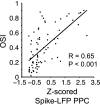Orientation selectivity and noise correlation in awake monkey area V1 are modulated by the gamma cycle
- PMID: 22371570
- PMCID: PMC3306673
- DOI: 10.1073/pnas.1114223109
Orientation selectivity and noise correlation in awake monkey area V1 are modulated by the gamma cycle
Abstract
Gamma-band synchronization adjusts the timing of excitatory and inhibitory inputs to a neuron. Neurons in the visual cortex are selective for stimulus orientation because of dynamic interactions between excitatory and inhibitory inputs. We hypothesized that these interactions and hence also orientation selectivity vary during the gamma cycle. We determined for each spike its phase relative to the gamma cycle. As a function of gamma phase, we then determined spike rates and their orientation selectivity. Orientation selectivity was modulated by gamma phase. The firing rate of spiking activity that occurred close to a neuron's mean gamma phase of firing was most orientation selective. This stimulus-selective signal could best be conveyed to postsynaptic neurons if it were not corrupted by noise correlations. Noise correlations between firing rates were modulated by gamma phase such that they were not statistically detectable for the spiking activity occurring close to a neuron's mean gamma phase of firing. Thus, gamma-band synchronization produces spiking activity that carries maximal stimulus selectivity and minimal noise correlation in its firing rate, and at the same time synchronizes this spiking activity for maximal impact on postsynaptic targets.
Conflict of interest statement
The authors declare no conflict of interest.
Figures





Similar articles
-
Orientation selectivity of synaptic input to neurons in mouse and cat primary visual cortex.J Neurosci. 2011 Aug 24;31(34):12339-50. doi: 10.1523/JNEUROSCI.2039-11.2011. J Neurosci. 2011. PMID: 21865476 Free PMC article.
-
A Distinct Class of Bursting Neurons with Strong Gamma Synchronization and Stimulus Selectivity in Monkey V1.Neuron. 2020 Jan 8;105(1):180-197.e5. doi: 10.1016/j.neuron.2019.09.039. Epub 2019 Nov 12. Neuron. 2020. PMID: 31732258
-
Rhythm and Synchrony in a Cortical Network Model.J Neurosci. 2018 Oct 3;38(40):8621-8634. doi: 10.1523/JNEUROSCI.0675-18.2018. Epub 2018 Aug 17. J Neurosci. 2018. PMID: 30120205 Free PMC article.
-
Pattern separation and synchronization in spiking associative memories and visual areas.Neural Netw. 2001 Jul-Sep;14(6-7):763-80. doi: 10.1016/s0893-6080(01)00084-3. Neural Netw. 2001. PMID: 11665769 Review.
-
Bottom-up and top-down dynamics in visual cortex.Prog Brain Res. 2005;149:65-81. doi: 10.1016/S0079-6123(05)49006-8. Prog Brain Res. 2005. PMID: 16226577 Review.
Cited by
-
Category-selective phase coding in the superior temporal sulcus.Proc Natl Acad Sci U S A. 2012 Nov 20;109(47):19438-43. doi: 10.1073/pnas.1217012109. Epub 2012 Nov 6. Proc Natl Acad Sci U S A. 2012. PMID: 23132942 Free PMC article.
-
Phase of firing coding of learning variables across the fronto-striatal network during feature-based learning.Nat Commun. 2020 Sep 16;11(1):4669. doi: 10.1038/s41467-020-18435-3. Nat Commun. 2020. PMID: 32938940 Free PMC article.
-
Stimulus repetition modulates gamma-band synchronization in primate visual cortex.Proc Natl Acad Sci U S A. 2014 Mar 4;111(9):3626-31. doi: 10.1073/pnas.1309714111. Epub 2014 Feb 19. Proc Natl Acad Sci U S A. 2014. PMID: 24554080 Free PMC article.
-
Snapshots of the Brain in Action: Local Circuit Operations through the Lens of γ Oscillations.J Neurosci. 2016 Oct 12;36(41):10496-10504. doi: 10.1523/JNEUROSCI.1021-16.2016. J Neurosci. 2016. PMID: 27733601 Free PMC article.
-
Cortical gamma-band resonance preferentially transmits coherent input.Cell Rep. 2021 May 4;35(5):109083. doi: 10.1016/j.celrep.2021.109083. Cell Rep. 2021. PMID: 33951439 Free PMC article.
References
Publication types
MeSH terms
Grants and funding
LinkOut - more resources
Full Text Sources
Medical
Research Materials

